Double wrapping your off-grid meals will guarantee juicy, flavorful results every time. Start with plastic wrap against the food to lock in moisture, then add aluminum foil as your outer protective layer. You'll want to press out air pockets and create tight seals on all edges to prevent steam loss. Choose moisture-rich ingredients like zucchini and cherry tomatoes, and incorporate binding agents like hummus or nut butters. Timing matters – plan for 15-20 minutes of cooking on medium-low heat, adjusting for weather conditions. The perfect wrapped meal combines technique, timing, and smart ingredient choices – there's so much more to discover about mastering this essential skill.
The Power of Double Wrapping
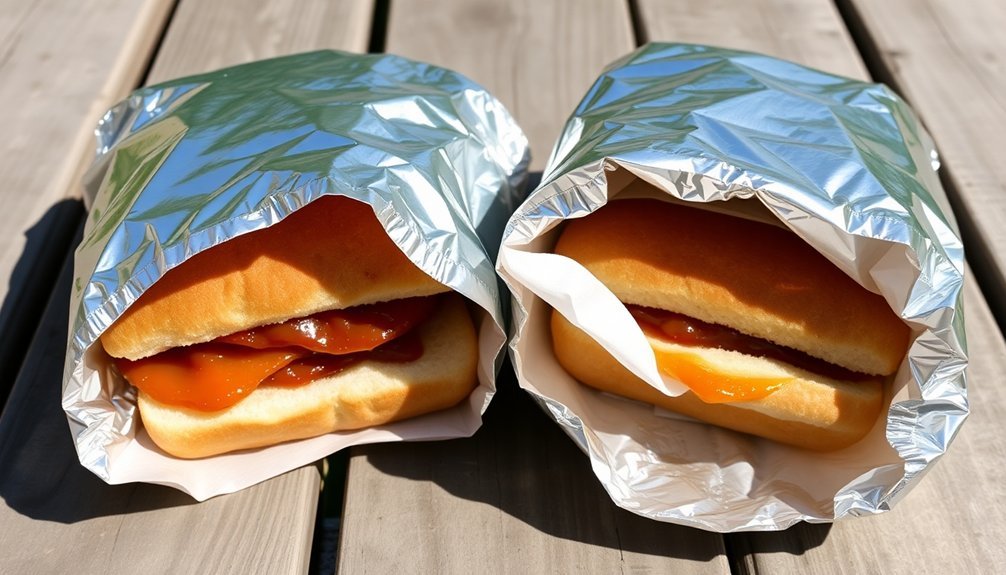
When you're cooking in shared or unfamiliar spaces, double wrapping your food is a powerful technique to maintain kosher standards.
You'll need two complete layers of aluminum foil or plastic wrap, ensuring there aren't any openings where steam could penetrate.
Double wrapping creates a protective barrier that prevents your food from coming into contact with non-kosher residue or absorbing unwanted tastes through steam.
The outer layer shields against any direct contamination, while the inner layer keeps your food perfectly kosher.
If you're using aluminum foil, remember to discard the outer layer after heating.
You can confidently reheat your meals in any oven, whether you're at a hotel or using communal facilities.
Regular oven cleaning is essential to minimize potential contamination risks.
This method works because absorbed tastes won't transfer between surfaces without liquid present, keeping your food both safe and delicious.
Choose Your Wrap Materials
Selecting the right wrap materials can make or break your off-grid cooking experience. For high-heat cooking, you'll want aluminum foil's excellent heat resistance and moisture barrier, though be cautious with acidic foods.
When storing fruits and vegetables, consider beeswax wraps – they're breathable, reusable, and won't leach chemicals into your food. Each wrap type has unique properties that make it best suited for specific storage needs.
Parchment paper's your best friend for non-stick baking, while silicone covers offer versatile, long-term storage solutions that work in any temperature. You can pop them in the microwave or oven without worry.
If you're concerned about waste, skip the single-use options. Instead, invest in silicone wraps or beeswax covers that you can clean and reuse. Just remember: don't use beeswax wraps for raw meat, and always clean your reusable options thoroughly between uses.
Layer Order Matters
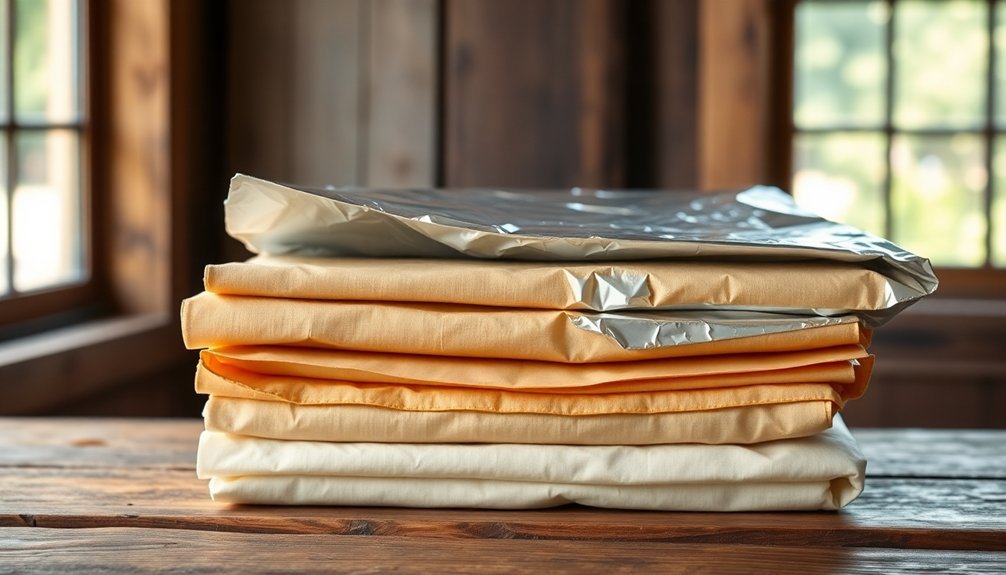
Start with plastic wrap directly against your food to lock in the moisture, then add aluminum foil as your protective outer barrier.
When wrapping hot foods, let them cool slightly first to prevent excess steam from making the wrap loose. This method is particularly effective for freezing baked goods that won't be eaten within a few days.
You'll want to press out any air pockets between layers to create the tightest seal possible.
Bottom to Top Assembly
Proper layering serves as the foundation for a successful wrap or en papillote. You'll want to place your ingredients in the center or bottom half of your wrapping material, whether it's a tortilla or parchment paper. Don't let your fillings cover more than a third of the surface – this guarantees you'll have enough space to fold and seal properly.
| Layer Position | Ingredient Type | Purpose |
|---|---|---|
| Bottom | Spreads/Sauces | Creates base seal |
| Second | Heavy Ingredients | Provides structure |
| Middle | Main Proteins | Centers the filling |
| Fourth | Vegetables | Adds texture |
| Top | Light Garnishes | Completes flavor |
Pack your ingredients tightly using a fork or spoon as you build each layer. This compression helps create a secure wrap that won't fall apart when you're enjoying your meal off the grid.
Prevent Steam From Escaping
To maximize the flavor and tenderness of your off-grid meals, you'll need to prevent steam from escaping during the cooking process. Select food-grade plastic wrap with moderate thickness and wrap your ingredients tightly, leaving an inch of space between the food and wrap to prevent melting.
Create a proper seal by checking for tears or cracks in the wrap before use. If you're cooking vegetables or fish, make a small vent by turning back one corner to prevent the wrap from splitting. This technique guarantees even heating while retaining moisture and original flavors.
Don't wrap fatty or sugary foods too tightly, as they can cause the plastic to melt.
Remember to remove the wrap carefully after cooking to avoid burns, and always discard it after a single use.
Tight Seals Prevent Steam Loss
You'll lock in maximum moisture by double-layering your food wraps, creating an impenetrable barrier against escaping steam.
Folding the edges with careful precision forms leak-proof packets that trap heat and condensation inside.
Your meals will stay juicy and hot longer when you take the time to create tight, properly sealed corners that prevent any unwanted moisture loss.
Double Layering Maximizes Heat
When preparing meals off the grid, double-layering your food containers creates a powerful insulation system that locks in heat and prevents steam loss.
You'll find that materials like aluminum, foam, and specialized plastics work best, as their low thermal conductivity slows heat transfer.
For maximum effectiveness, choose containers with air gaps between walls or wraps with honeycomb patterns.
These designs trap air in tiny pockets, creating an extra barrier against temperature loss.
You'll want to pair this with proper ventilation control – small vents let excess steam escape while maintaining warmth.
Look for packaging with secure snap-on lids or tight seals that won't accidentally pop open.
Advanced options like Aerofoil's Air Lock Technology can give you even better results, utilizing micro-layers to keep your meals hot and fresh longer.
Folding Creates Perfect Packets
Building on the heat-retention principles of double layering, proper folding techniques create airtight food packets that seal in warmth and moisture.
You'll want to master these essential wrapping methods to guarantee your off-grid meals stay hot and juicy.
The standard fold method works best for most scenarios, but you've got options depending on your needs:
- Use the standard fold for maximum control over filling distribution and steam retention
- Try the cylinder roll when you need a quick, secure wrap for meals on the move
- Choose the envelope fold for a traditional approach that prevents filling spillage
- Opt for the tick tock hack when you want four distinct flavor sections
- Apply sauce along the final edge to create an extra seal that locks in heat
Moisture Adding Ingredients
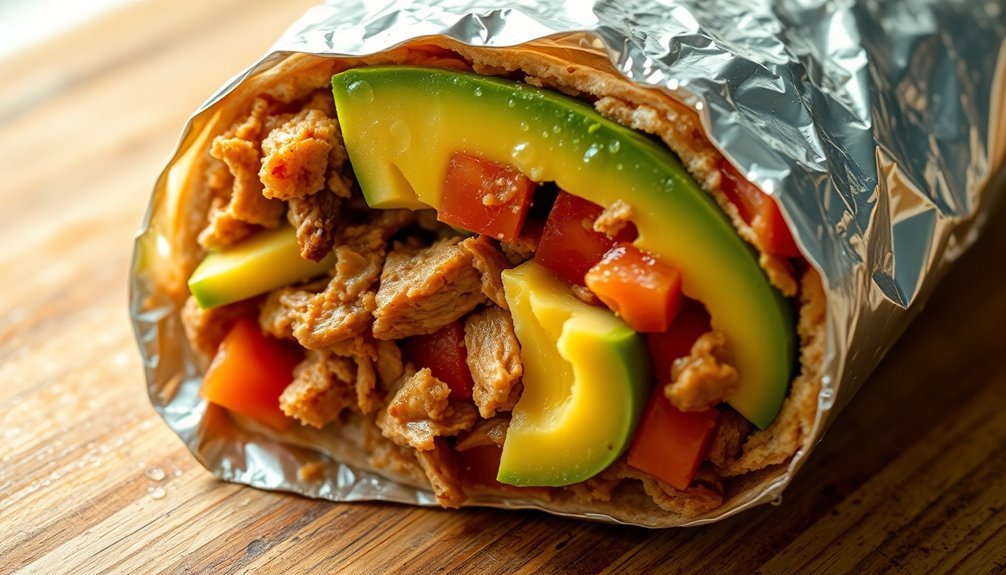
Creating juicy, satisfying meals off-grid depends heavily on ingredients that contribute natural moisture and texture. You'll find zucchini and cherry tomatoes rehydrate exceptionally well, while kale retains moisture naturally in salads.
For added richness, incorporate olive oil or coconut oil into your dishes.
Don't overlook dairy options – parmesan packets and freeze-dried mozzarella bring creaminess when melted, while yogurt mixed with olive oil creates luxurious textures.
For dairy-free alternatives, nutritional yeast and coconut aminos work wonderfully. Your sauces can stay moist by combining tomato powder with water, or mixing tahini with lemon and apple cider vinegar for dressings.
When cooking vegetables like broccoli and carrots, slice them thin and add bell peppers near the end to maintain their natural moisture and crunch.
Solar Oven Temperature Control
Successful solar oven cooking hinges on maintaining ideal temperatures between 300°F and 400°F for most dishes. You'll need to monitor and adjust your setup throughout the cooking process to achieve consistent results.
- Position your oven to face the sun directly and realign every 30-45 minutes.
- Line the bottom with black construction paper and use dark cookware.
- Install multiple layers of insulation using cotton, newspaper, or packing peanuts.
- Create airtight seals to prevent heat from escaping.
- Cook during peak hours (11 AM to 3 PM) for prime performance.
Keep track of internal temperatures using a thermometer and adjust accordingly. Wind can notably impact your cooking temperature, so choose a sheltered spot.
For maximum heat capture, make sure your reflective surfaces are clean and properly angled using a ruler to direct sunlight into the cooking chamber.
Timing Your Wrapped Dishes
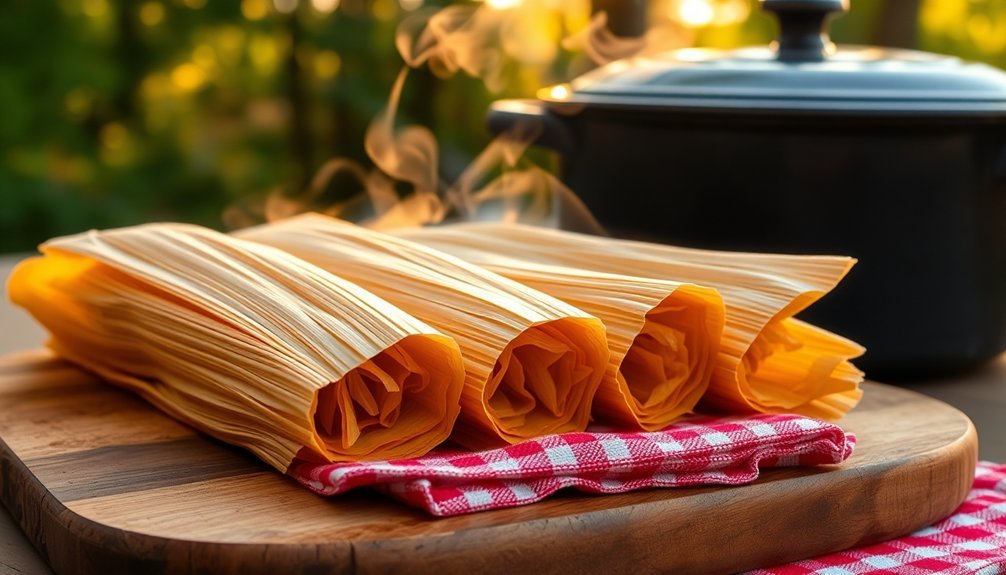
When preparing wrapped dishes for off-grid cooking, proper timing can make the difference between a perfectly cooked meal and an undercooked disappointment.
You'll want to aim for medium-low heat when cooking foil-wrapped meals on your campfire or grill. Most foil packet dishes need 15-20 minutes to cook thoroughly, though roast beef sandwiches require just 10-15 minutes.
Remember that cold weather will extend your cooking times, so you'll need to adjust accordingly. Always check the meal's doneness carefully, and be cautious when opening the foil packets to let steam escape.
For vacuum-sealed meals, defrost them overnight in your cooler, then reheat using hot water. You can speed up the process by massaging the bag periodically to guarantee even heat distribution.
Best Foods for Wrap Cooking
Selecting the right ingredients for wrap cooking can transform your off-grid meals from basic to extraordinary.
You'll want to choose ingredients that maintain their texture and flavor while being portable and easy to store.
- Tortillas and pita bread are ideal wrap bases as they're durable and stay fresh longer than delicate options like crepes.
- Pre-cooked chicken, falafel, or canned tuna make excellent protein choices that won't spoil quickly.
- Hummus, cream cheese, and nut butters serve as perfect binding agents while adding rich flavor.
- Beans and lentils provide hearty, shelf-stable protein alternatives that don't require refrigeration.
- Crunchy vegetables like carrots, cabbage, and bell peppers maintain their texture better than leafy greens.
Remember to layer your ingredients strategically, placing moisture-rich items between drier components to prevent sogginess.
Unwrapping at Peak Doneness
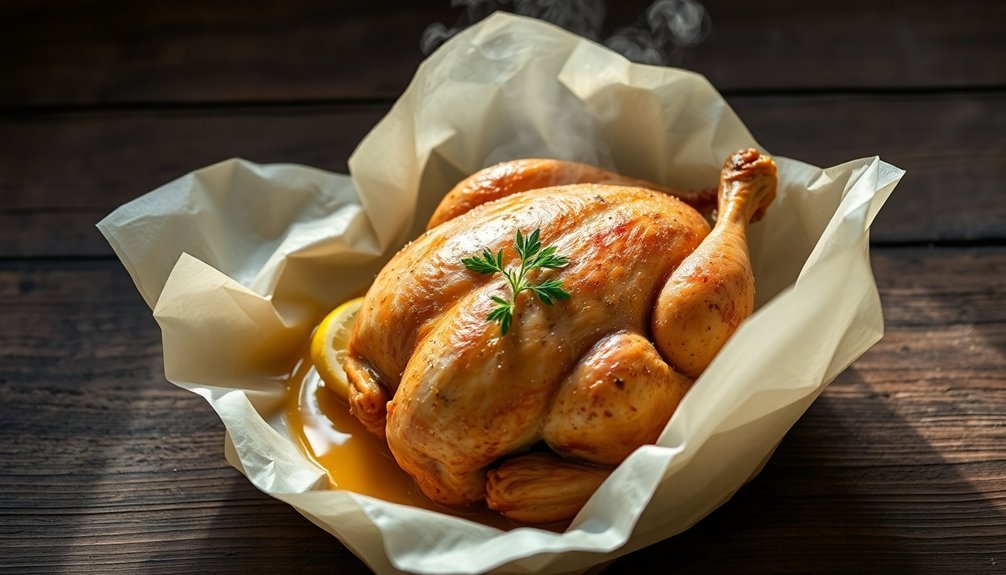
After mastering the art of wrap ingredients, timing your unwrapping process can make or break your meal's success. You'll need to monitor internal temperatures carefully and recognize the perfect moment to reveal your creation.
| Meat Type | Wrap Until | Unwrap At |
|---|---|---|
| Brisket | 165-170°F | Final bark formation |
| Frozen Cuts | Before cooking | Fully thawed |
| Storage Meats | During freezing | Usage date |
For briskets, you'll want to watch for the stall period around 165-170°F before wrapping. Choose between foil for speed or butcher paper for enhanced smoke flavor. When storing cuts, confirm you've created an airtight seal with quality freezer paper, keeping the shiny side against the meat. Double-wrap particularly valuable cuts using foil as an outer layer for extra protection against freezer burn.
Frequently Asked Questions
Can I Reuse Foil Wraps for Multiple Cooking Sessions?
You shouldn't reuse foil wraps for cooking. They'll degrade, tear, and may harbor harmful bacteria from previous use. For your safety and best cooking results, always use fresh foil for each meal.
How Do I Prevent Food From Sticking to the Wrapping Material?
You'll prevent food sticking by placing parchment paper between food and wrap, letting items cool before wrapping, and ensuring surfaces are dry. For plastic wrap, try storing it in the freezer to reduce stickiness.
What Safety Precautions Should I Take When Wrapping Raw Meat?
You'll need to use leak-proof packaging, wash hands thoroughly, keep separate cutting boards for raw meat, wrap tightly to prevent drips, and avoid cross-contamination. Don't leave meat at room temperature.
Is Wrap Cooking Safe for Children to Help Prepare?
You should supervise kids when wrap cooking. Let them help with safe tasks like measuring ingredients, but handle raw foods and hot temperatures yourself. Always enforce hand washing and kitchen safety rules.
How Long Can Wrapped Food Stay Warm After Cooking?
You'll keep food warm for 2-4 hours if properly wrapped in aluminum foil and insulating materials. However, for food safety, don't let hot foods stay between 40-140°F (4-60°C) for more than 2 hours.
In Summary
You'll find wrapped cooking revolutionizes your off-grid meals with consistently juicy results. By mastering the double-wrap technique, selecting proper materials, and managing moisture levels, you're set for success. Remember to monitor cooking times and temperatures in your solar oven carefully. When you've nailed these fundamentals, you'll create tender, flavorful dishes that rival conventional cooking methods every time.





Leave a Reply